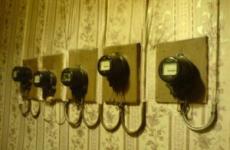Scheme of the fuel system of the engine. Fuel system diagram
Whatever you may say, but among the majority of Russian automobile inhabitants, diesel is still associated with trucks, agricultural equipment and other tractors. “Tarahtit, does not go, you will always stink with solarium” - these are typical images of heavy-fuel motors, formed by prolonged communication with engines that are not much different from the one that Rudolf Diesel patented more than a century ago. Meanwhile, the unit during its evolution got to serious sports such as rally-marathons or circuit races for endurance like 24 hours of Le Mans. And if the work, tough compared to gasoline installations, and the specific smell of diesel fuel remained integral components of a diesel engine, then the power indicators are far from tractor. But the former unpretentiousness with the fuel omnivorous remained in the past.
In fairness it should be noted: for all his life, diesel always lagged behind the development of a gasoline engine. The latter played with the number of valves with the ignition system. He got the system of variable valve timing and various options for boosting. In the end, the electronic fuel supply control gasoline units in the bulk received much earlier.
What about diesel? We will be wrong if we say that the designers did not work on it. Recall that at the end of the 19th century, Rudolf Diesel himself experimented with coal dust as fuel. Work was carried out on a two-stroke engine, promising in terms of power. It was used on armored vehicles, diesel locomotives, even aircraft, in particular, Luftwaffe bombers (by the way, aircraft engineers and a four-stroke engine did not bypass; such, for example, was installed on the Soviet Pe-8). Now, being initially dirty on exhaust, diesel "two-stroke" is used only on sea-going ships. On them, there are often units in which a special insert is arranged to increase the long-distance between the piston and the connecting rod. But these are all "parallel branches of evolution." But what about the installation on a more familiar to us technology?
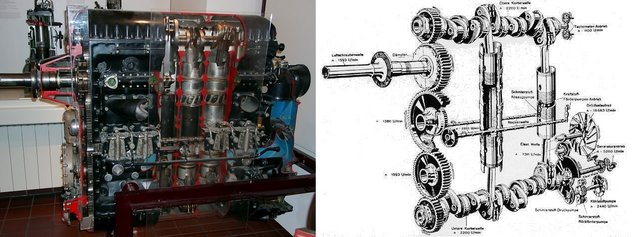
In the first half of the 20th century, experiments with diesel wore quite exotic forms. Here is a two-stroke boxer engine Junkers Jumo 205. 6 cylinders, more than 16 liters of volume, 867 forces - it seems like nothing unusual. However, the pistons 12, they are arranged vertically, moving towards each other and are driven by two crankshafts
Passenger diesel engines lagged behind their heavy counterparts. Suffice it to say that turbocharging, known for large, including aviation, units from the first half of the 20th century, appeared on passenger engines by the end of the 70s. The fuel crisis and various environmental standards adopted in different countries contributed to the development of compact diesel engines. After all, the content in the exhaust of carbon monoxide in diesel is less than that of a gasoline engine.
The work was mainly carried out to optimize the mixing and combustion of the air-fuel mixture. It is known that for this purpose, a prechamber was used, which first took in the fuel. In it it is well mixed with air. Having ignited, the mixture, due to the difference in pressure, got into the main combustion chamber and ignited the air there. The opposite solution was to position the nozzle directly in the cylinder. However, the traditional combustion chamber of such diesel engines was absent, since there was no space above the piston when the piston was in the TDC. The fuel was injected into the recess in the piston crown. Each design had its advantages and disadvantages. For example, pre-chamber diesel engines differed in soft work, but the worst starting characteristics and increased appetite. In this case, neither in one nor the other case could a person achieve a significant increase in power or increase in economy.
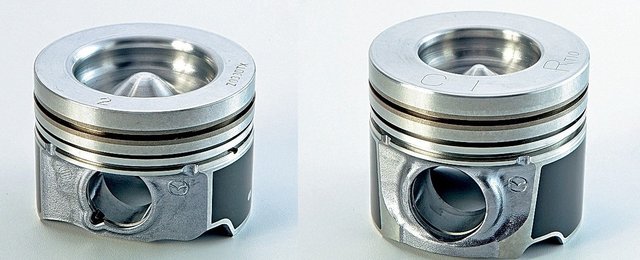
Direct injection diesel engines have a combustion chamber made in the piston. They work harder for the chamber, but more economical than them. However, prechamber and vortex cameras are already past. All the injectors of modern diesel engines are located directly in the cylinder
How could not do it with the use of two types of fuel systems. Neither a row-type apparatus, where the number of plunger pairs was equal to the number of cylinders, nor a fuel pump high pressure (Fuel pump) distribution type with a single plunger could not fundamentally improve the process of fuel supply. They tried to do this in the late 80s and early 90s, using the so-called two-phase injection. For example, the company Isuzu and MAN in the spray nozzles were placed on two holes. Through one small amount of fuel entered the center of the combustion chamber, through the other more - on its walls. A little later, thanks to the development of electronic control, it was possible to realize the cooling of the combustion chamber — by injection of diesel fuel at the end of the compression stroke. This made the ignition softer and more controllable. And, nevertheless, the old principles of fuel supply could no longer meet the requirements for diesel engines, including in terms of harmful emissions. There was only one way out of this situation for all designers - a significant increase in fuel supplied to the cylinders. But to do this using traditional solutions was not possible. The fact is that the injection pump does not give constant pressure all the time - it is tied to the engine speed, to the mode of operation. That is why fuel pulsation occurs in the highways. And if the pressure is significantly increased, the destruction of the fuel lines will occur.
The high pressure fuel pump is a high pressure fuel pump - a key component of the fuel equipment of diesel engines. Even at the dawn of the emergence of engines operating on diesel, it was clear that for high-quality mixing with air and ignition, it must be fed into the combustion chambers under high pressures. The first experimental fuel pump appeared at the beginning of the last century. In the late 20s, Bosch launched a serial pump for cargo installations, and in the 30s debuted a unit for passenger engines.
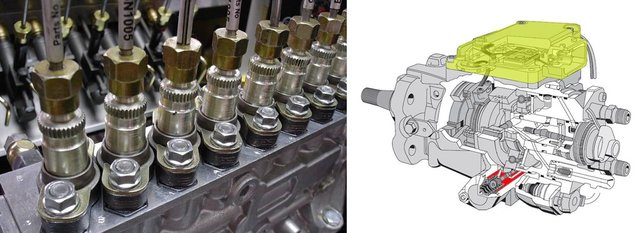
The fuel equipment of the row (left) and distribution (right) types did not differ in the quality of the spray pattern. Although the supply of diesel in the second case was more uniform. Rather, the layout decisions and a certain margin of necessary reliability, according to which the in-line TA, of course, won
Dead end path
One of the first to resolve this issue was Isuzu. In 1998, the Japanese used an interesting system on a three-liter diesel 4JX1, which was installed on the firm’s jeeps, on the Opel Monterey and Frontera. It contained a high pressure oil pump and a conventional fuel pump. The nozzles carried plunger pairs and also contained engine oil (on top of the plunger) and diesel fuel (on the bottom of it). The pressure of the injected fuel increased due to the pressure of the oil, which was increased by processor commands. The motor for that time turned out to be quite powerful, high-torque, economical and smooth in operation. However, the owners of the Isuzu and Opel SUVs commented on these engineering experiments with an unkind word. So, rubber seals, designed to separate in the nozzles lubricating and combustible fluids, did not differ a great resource. Diesel mixed with oil, the pump at idle or medium speed could not create enough for high-quality spray pressure. Engine gloh or stopped pulling. Other seals in the nozzles separated the coolant. And they also did not differ outstanding service life. Diesel mixed with antifreeze.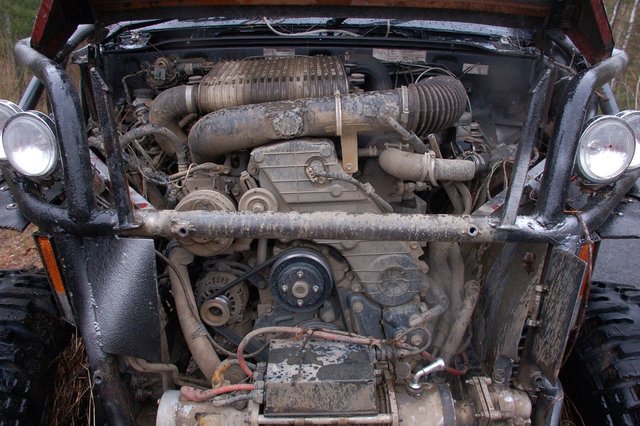
Everyone was good at 4JX1, but when he exchanged 100 thousand km ... Spray nozzles, but there were really cases in which, due to diesel in the crankcase, the owners had not only to restore the fuel equipment, but also the engine capital
Another reason for the appearance of diesel fuel in the crankcase with all the ensuing consequences was the fuel pump. Diesel leaked through the rod due to its wear. Curiously, in mid-1999, Opel recalled cars from 4JX1 to replace seals. A year later, the design of the nozzles was changed. In 2001-02, the release of the engine stopped altogether.
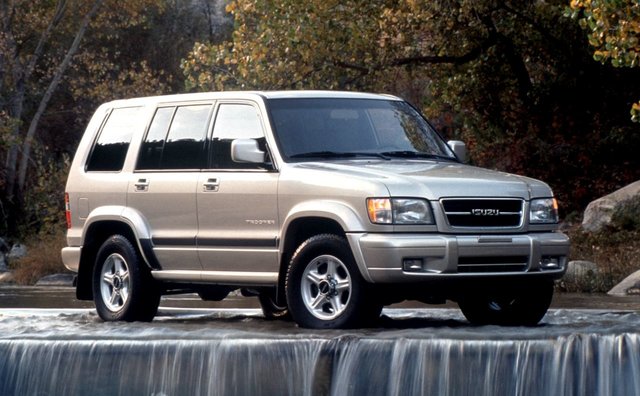
At one time, the export Trooper (or its internal counterpart Bighorn) enjoyed a small but steady demand. He had a certain charm - a classic appearance, frame base, torsion bar front suspension and non-differential four-wheel drive with a multiple transmission and a function of automatic connection of the front axle. But with a diesel engine SUV out of luck
Despite the shortcomings, the Japanese engineers nevertheless solved the main problem - there were no pressure waves in the system, more precisely, the fuel pressure itself was low, since oil was responsible for the injection. In other words, the role of the usual injection pump played a high-pressure oil pump. But the designers of VW, in collaboration with colleagues from Bosch, chose a different path. The Germans did not abandon the injection pump - from the fuel lines.
Two in one
About the union of the pump, plunger pair and nozzles thought at the dawn of the dizelizatsii transport. It is rumored that Rudolf Diesel saw the fuel supply system just like this - devoid of highways. In the middle of the last century, mechanically controlled pump nozzles began to take root in large units, cargo or, say, shipboard, although they didn’t talk about the development of some kind of extreme pressure then. From the mid-90s, these parts, already under the control of electronics, began to be used on trucks. And in the late 90s, pump-injectors appeared on Volkswagen passenger engines.In addition to the device injectors, the differences from conventional injection pumps are that traditional highways in such systems do not. Since the pump-nozzles are installed directly on the cylinder head, their role is played by the channels in the cylinder head. And they, by themselves, are able to withstand very significant pressure and its change. Another feature of this scheme, however, associated with the development of radio electronics, is electromagnetic valves, which allow fuel to be injected several times per cycle. In the middle of the last decade, piezo jets appeared. They use the so-called piezoelectric effect - voltage is applied to special crystals, and they change the volume from this by lifting the nozzle needle. With the seeming futurism, the piezoforsunks determined a new level of fuel spraying. They work several times faster than electromagnetic, allowing you to inject diesel more often and achieve a more complete combustion of fuel.
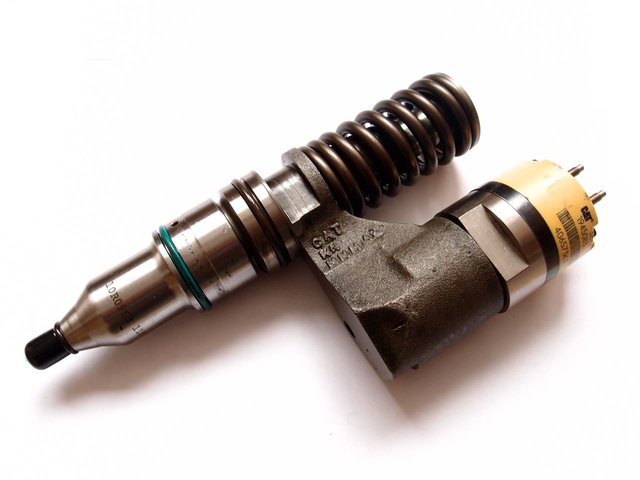
The main problem of pump injectors is the layout in the head of the unit, where they take up a lot of space. Therefore, mostly diesel engines with him have two valves per cylinder. Although the VW still had two-liter 16-valve engines. Rather, the exception. For example, the same Touareg on the 2.5-liter "five" and five-liter V10 with pump-nozzles only two valves. For consumers, these details are a powerful catalyst for the growth of the repair budget.
However, the pump-injectors have inherent design flaws. So, because of their bulkiness, the layout of the head of the block is complicated. And the drive from a cam-shaft causes the same dependence on engine turns, as well as at former fuel systems.
Perfection limit
Attempts to "untie" the modes of the engine and the pressure on the injection have been made for a long time. In World War I, something similar to current systems common rail for submission of diesel and fuel oil on the engines of submarines used the British company Vickers. Supposedly back in the 20s of the last century, Soviet engineers were engaged in this. And in the 60s, theoretical constructions were offered and prototypes were created by Swiss designers. It was not necessary to talk about the introduction of the pipeline - technology did not allow it. In the first half of the 90s, especially in Japan, they, of course, had already risen to the desired level. Denso Corporation has offered common rail with electronically controlled on the diesel truck Hino Ranger in 1995. And the Fiat concern, in collaboration with Magneti Marelli, first used the system in 1997 on the Alfa Romeo 156. Now the common rail is used almost everywhere. Rare firms, and even then not on all models, prefer the pump nozzles. Why?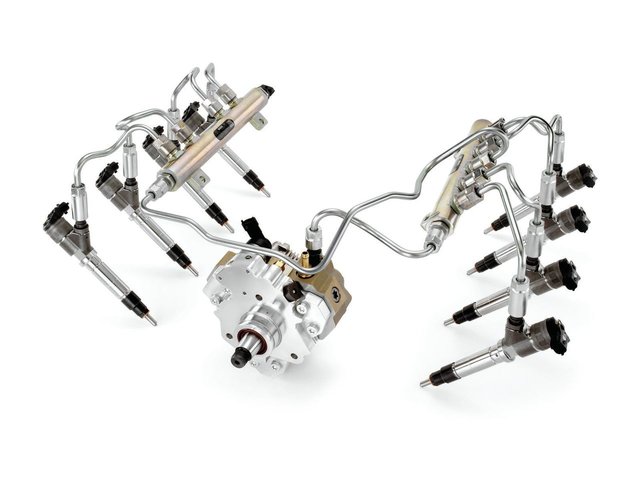
The scheme of the common rail system is not as complicated as it may seem. Booster pump (not shown), injection pump, ramp-pressure accumulator and nozzles. Previously, the implementation of a similar principle of fuel supply did not allow materials processing technology.
The explanation is in the name of the system, because common rail in translation means “common line”. Or ramp, or high pressure accumulator. In fact, the pipe-tank, where the injection pump "presses" the fuel and maintains a constant pressure there. And already from it diesel fuel goes to the injectors (electro-hydraulic or with piezo elements). Moreover, the pressure depending on the operating modes, controlling the pump, sets the processor. And it does not depend on the sequence and frequency of injection. Moreover, since the advent of the common rail, the pressure is constantly raised. In the late 90s - early 2000s, pumps developed 1200-1300 atm., Against 1000 atm. in ordinary injection pump. The maximum reached now is 2200 and even 2500 atm. This is, if not a limiting value, then, in any case, very close to it. Further development of injection with a pressure accumulator can probably develop only in control electronics. But the alternative to the "rail" is not yet visible. As for the further tightening of environmental requirements, they will obviously be met by improving catalytic converters.
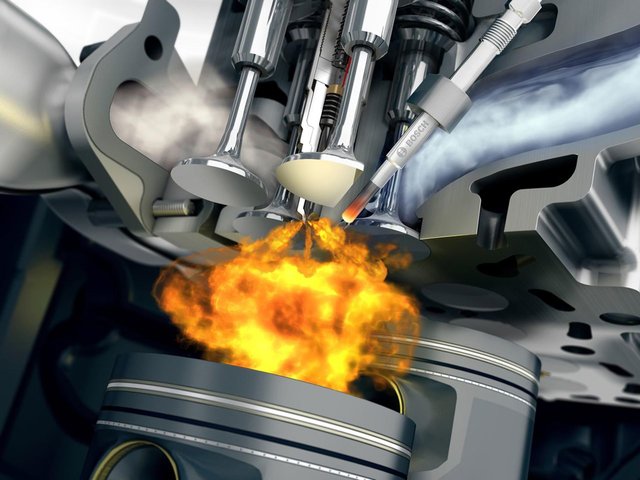
In addition to better spray and more complete combustion of the fuel, the pump-injectors and common rail helped to realize multi-pulse injection - up to 4 or more diesel feeds per cycle. This made diesel engines more economical and more environmentally friendly.
The collapse of stereotypes
Alas, as in many attributes of the technical progress in the automotive industry, there is no reason to expect a return to the old diesel operating principles. With regard to heavy-fuel engines, there is even some irony of fate and ridicule of the creators. After all, diesel has always been almost synonymous with forgiveness in operation. Did you swill into the tank of the slurry purchased from a familiar tractor driver or went to wade the river along a windshield (of course, with a snorkel). He jibes "and will go further. Now, like passenger cars with gasoline engines equipped with direct injection, any common rail vehicle is tied to gas stations with high-quality fuel. What to do to those who want to buy, say, a new pick-up SUV, but he lives away from the "centers of civilization"? A question without a specific answer.Meanwhile, some owners, especially those who had previously had unpretentious diesel engines of past generations, still believe in the omnivorous nature of the engines. Disappointment can come quickly. One refill with diesel water rich in water is enough to break the fuel pump in the common rail or fuel pumping elements in the pump injectors. And what is the resource parts in greenhouse conditions?
By replacing the injectors you need to be ready for runs within 100-150 thousand km. For precision performance, if we are talking about electromagnetic components, will have to pay from 10 to 20 thousand rubles. Worse for the owner of the pump-injector, which on some engines prefers VW. These can be estimated at 25,000 apiece, and well over 30. Piezoforsunki - the privilege of mostly European cars - can cost even more. From 25 to almost 40 thousand rubles.

Piezoforsunki (left) gradually come to replace the electromagnetic (right). The rate of change of the size of piezocrystals that raise the needle is higher than that of an electromagnet that does the same. This allows you to increase the frequency of injection per cycle. But when they wear out, all fuel savings look ephemeral — the price difference can be fourfold.
Fuel pump live longer - up to 200-250 thousand km. But in some cases we can talk about 300,000 or more thousand kilometers. True, and pay for the replacement will have more - 40-70 thousand rubles. Some pumps (however, like nozzles) can be restored in major cities of the country - and save up to half the amount. The opposite situation, when metal shavings from a damaged fuel pump gets to the ramp, nozzles and sneaks through the return pipe into the tank. Some manufacturers in the repair procedures include the replacement of the latter and highways.
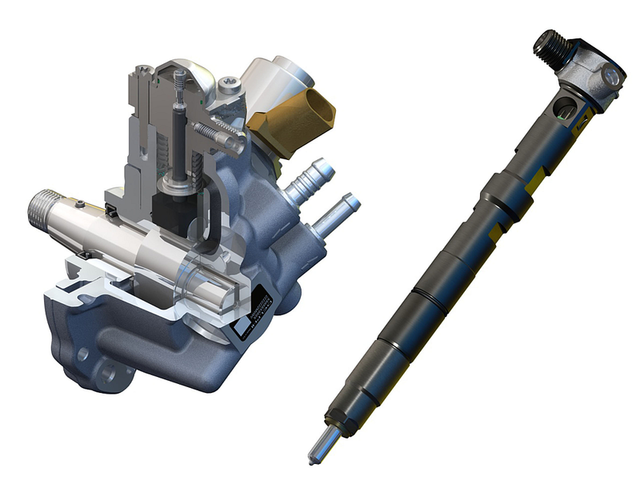
With good fuel A fuel pump can move almost to the engine's capital. On the other hand, the pump can be sentenced by just one gas station. Water has a particularly damaging effect on it.
Before natural wear and tear of system components, when using high-quality diesel fuel, there are other troubles. For example, the three-liter Touareg of the first generation and the Discovery III with a 2.7 l diesel responded to replace the injection pump. Two-liter VW diesel engines with common rail with a run of about 100 thousand km are disturbed by nozzle seals. In some Mercedes units (2.1 and 3.0 l), sometimes pressure regulators and nozzles (2.1 l are supplied, changed by the manufacturer). In others (another 2.1 and 2.7 l), the removal of an attached injector after 100 thousand km may lead to replacing not only it, but also repairing or changing the head of the block. Lubricate! Nozzles are killed when removing them on the Ssang Yong. This can lead to washing the engine under pressure. The repair process will also provide a procedure for replacing glow plugs. They are arranged in deep and narrow wells. Some mechanics have learned how to get out of the situation. But those who lack the ingenuity are forced to remove the nozzles - a cheap operation translates into a serious financial recovery.
There are enough problems for the owners of Nissan Navara - the failure of the pressure regulator, the failure of one of the sections of the fuel injection pump, apparently defective injectors, whose malfunctions were not directly related to the quality of the fuel. Similar troubles, with the exception of the pump, pursue and diesel Hyundai / Kia.
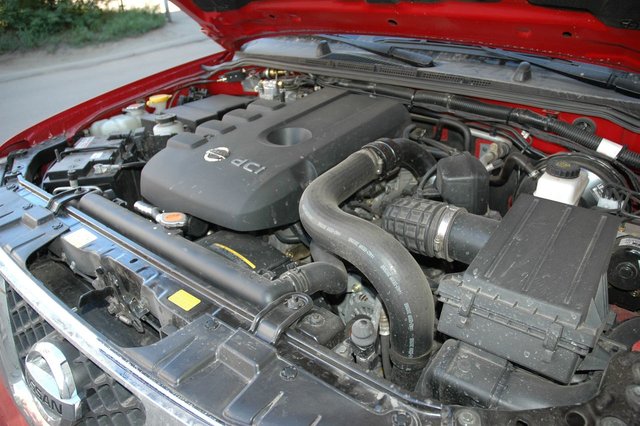
YD25, which is installed on the Nissan Navara and Pathfinder, as well as a number of models for the domestic market of Japan, the long-suffering motor. Conventional fuel equipment caused a lot of trouble. It was replaced by the common rail, but in this case the diesel remained problematic precisely on the fuel supply system
Simple rules
With all its tenderness, modern fuel equipment in comparison with the previous mechanical systems has undeniable advantages. Firstly, diesels do not have the shortage of predecessors with it - they do not heat up or boil because the injection advance angle is gone. Secondly, the diagnosis of common rail and pump injectors is much simpler than that of mechanical systems. There is a downside - the manufacturers of Denso equipment (“Japanese”, Ford, Land Rover) and Siemens (Land Rover), unlike Bosch and Delphi, supply parts and information to the secondary market with a “delay” of several years. Such is the link to the official dealers. And to the nozzles there are sprayers only in rare cases. Hence the high cost of repairs.How to protect yourself? The case when the choice of gas stations is crucial. It is not out of place to ask for a fuel quality certificate. It should be installed between the tank and the main Separ filter. It will not cut off fine inclusions, but it will not allow water to the pump and will not overload the booster pump. Of course, it is impossible to drive “on a light bulb”; it is advisable to choose the original ones from the filters and change them no less than after 5-15 thousand km. In general, you need to do something the same as with respect to the former fuel equipment. Only the issue price is much higher. And, of course, it’s a pity that at least on the most expensive cars, such as pick-ups and now rare honest jeeps, one cannot see the old fuel pump and nozzles that were able to work on a mixture of water and sulfur. Because, after all, the Russian fuel reality is very far behind the current technical realities.
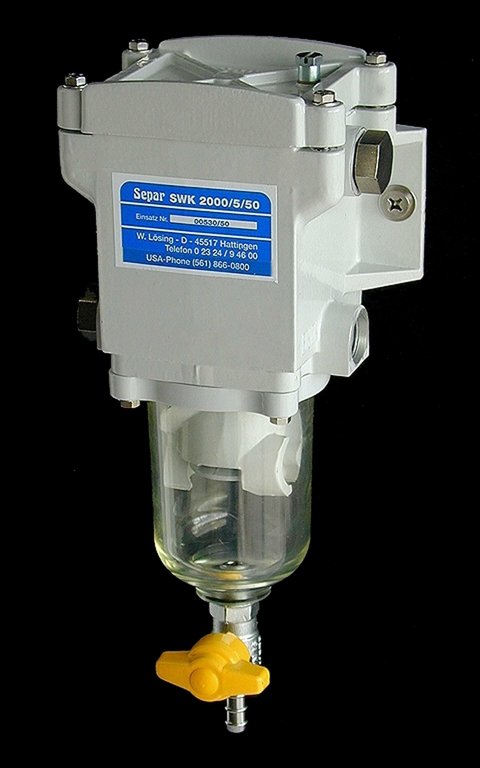
The filter separator will not provide cleaning at the level of the main original filter element. But it will save from the water that is found at our gas stations. And thanks to the transparent flask from the bottom, you can track the quality of the filled diesel fuel by sight.

Viktor Ivashkevich, Technical Director of the STO Politekh-Avtograd, professional experience over 10 years
- In addition to the choice fuel quality and the installation of Separa, it is in some cases (say, refueling at a dubious gas station on a long trip) to check the state of diesel fuel. It is enough to drain the fuel from the filter and see if there are any foreign inclusions. The worst option is metal shavings. In such a situation, it is necessary to go further, to conduct an audit of the pump and injectors. The latter, by the way, it is desirable to periodically diagnose and clean. Nevertheless, our fuel far from everywhere meets the requirements that modern diesel engines place on it.
Scheme fuel system - This is an element of the car that requires special attention, because the car is not just a means of transportation, it is our hobby, passion, and sometimes life. The fuel system is a fundamental component of any car. It is designed to provide the engine with fuel, fuel storage and its purification.
The system design and its operation
Nowadays there are several different fuel systems consisting of the following common nodes:
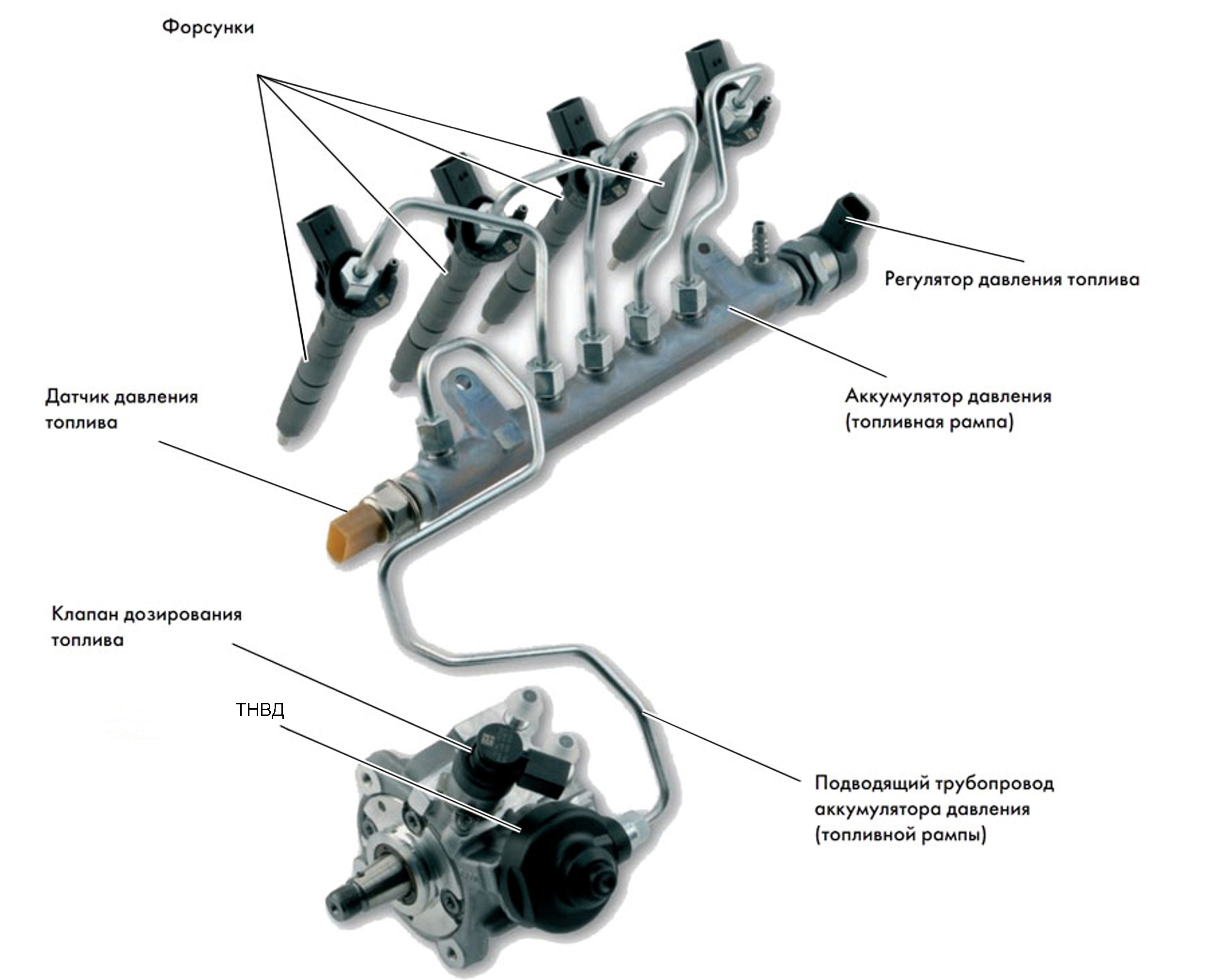
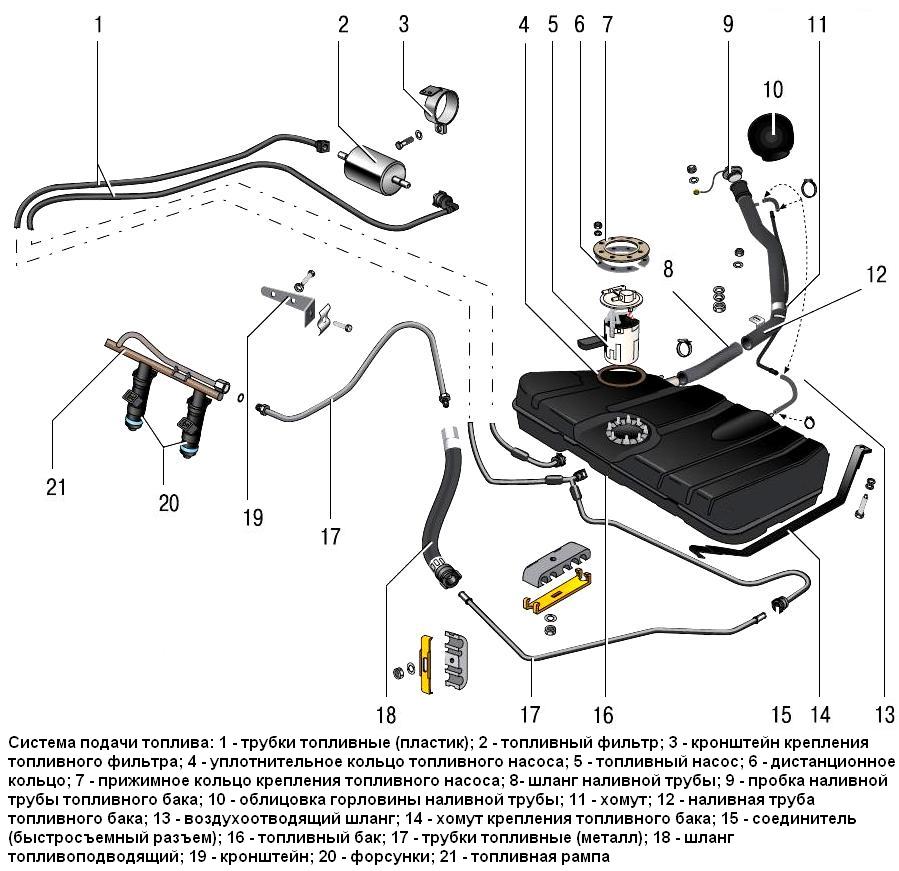
The scheme of the fuel system is quite simple. When the ignition system is turned on, the fuel deposit starts working, which pumps fuel from the tank into other elements of the system. As the fuel passes through, it is cleaned, then it enters the injection system, in which the mixture of fuel and air is formed. As a result, this mixture is in the combustion chamber, where it ignites, and engine gets the energy needed to move the car. This cycle repeats as the car moves.
Types of fuel systems
In modern cars are mounted diesel and gasoline engines that use different types of fuel supply. In addition, gasoline engines are divided into two types: carburetor and injection engines.
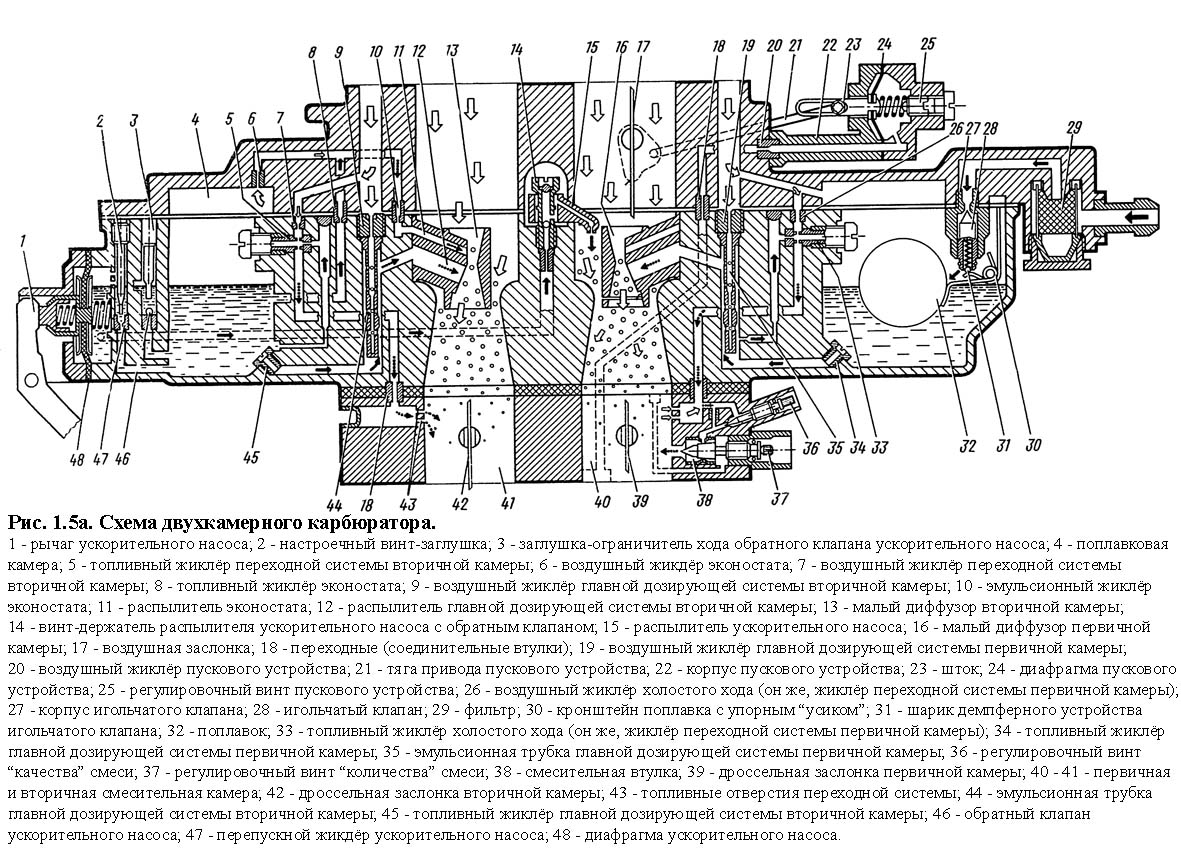
Carburetor and its features
A carburetor is a special device that is responsible for mixing fuel with air. The carburetor is mounted on the intake manifold, to which fuel is supplied. In it, using jet nozzles, fuel is mixed with air, then through the throttle valve it enters the manifold and is directed to the engine cylinders.
The principle of the injector
The fuel injection system from the carburetor is fundamentally distinguished by the following nuances:
- in this system, fuel is fed from the tank to the ramp attached to the injectors (dispensers);
- air to create a mixture enters through the throttle unit;
- the pressure created in the fuel lines and the pump far exceeds the pressure in the carburetor. This feature is associated with the need for rapid injection of the mixture into the combustion chamber;
- the operation of the fuel system (more precisely, fuel injection) is the responsibility of the electronic device.
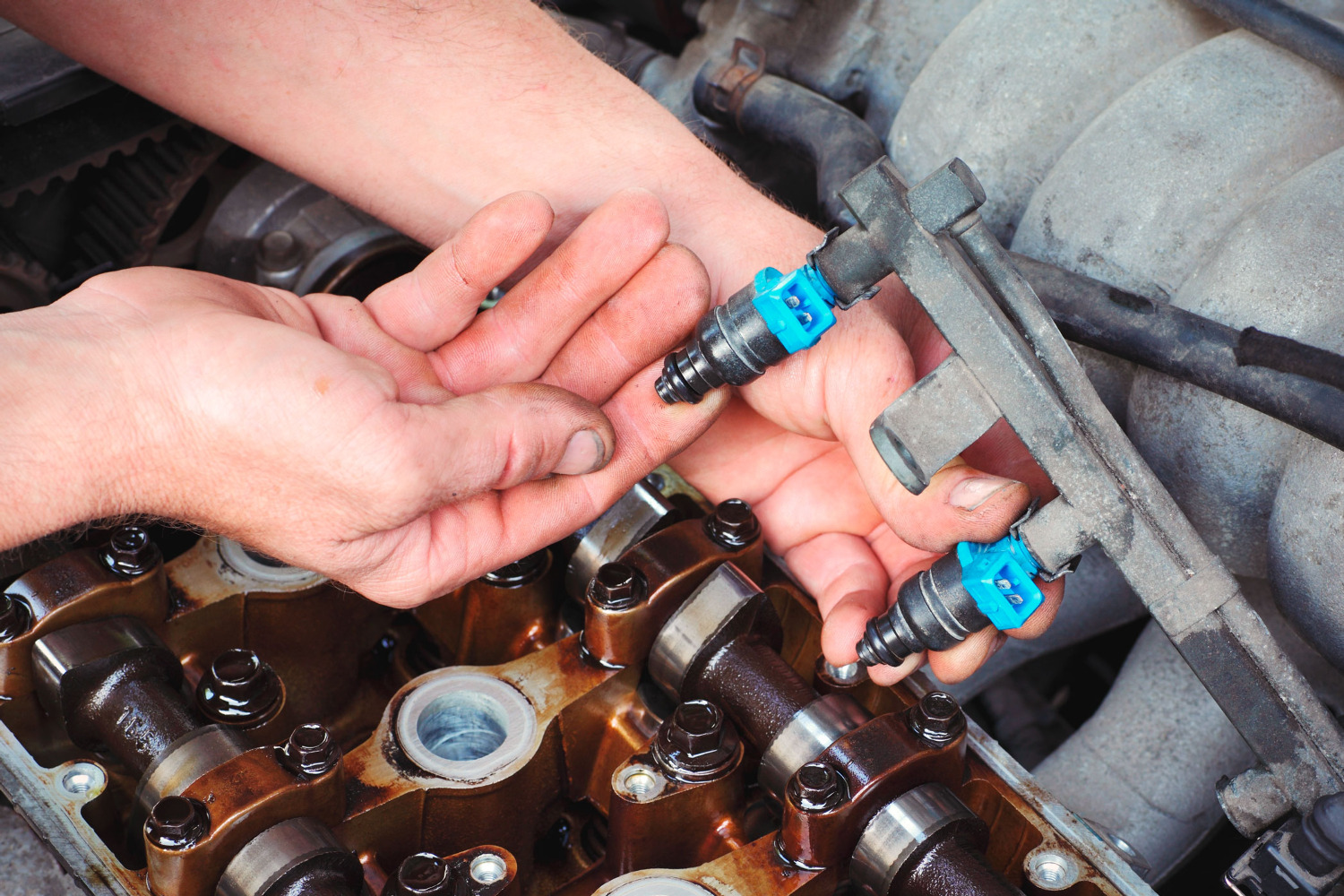
Injection systems can be single injection and distribution.
Single-injection injection systems are not the best option, since one nozzle cannot fully supply all cylinders with fuel.
On distribution systems, each cylinder has its own nozzle, so the engine runs at full capacity, and for this reason, such a system is preferred by modern manufacturers.
The fuel injection system starts its work in the same way as the others: when ignited, the fuel pump is turned on and the fuel enters the fuel lines, but then it ends up in the rail, which is always under increased pressure. From the ramp fuel enters the nozzles responsible for the flow of fuel into the combustion chambers. The formation of an air-fuel mixture occurs in them. The function of the injectors is controlled electrical equipment and various sensors, and it is on their signal that fuel is injected.
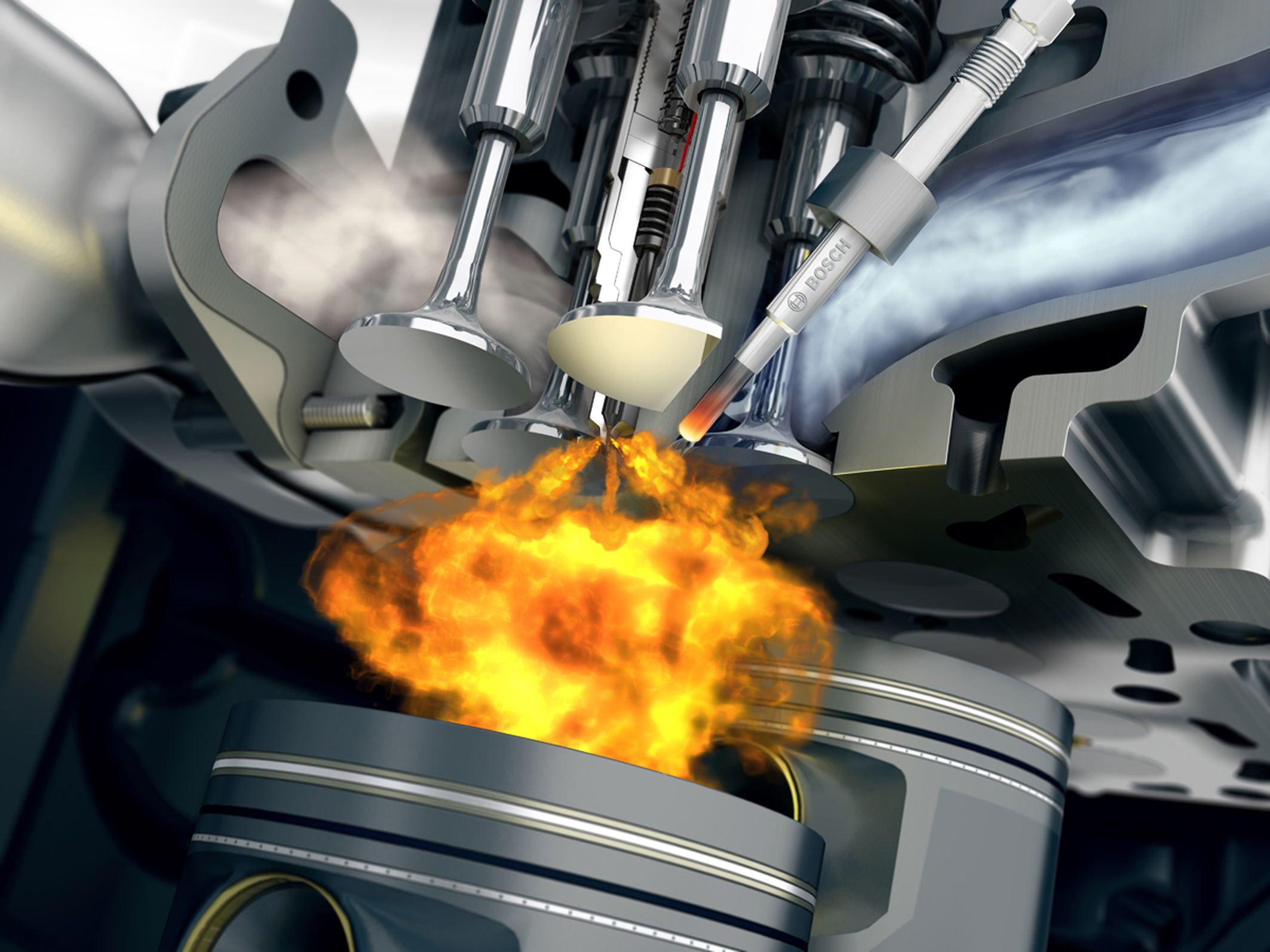
Diesel fuel system
The scheme of the diesel fuel system is different from the above. In such a fuel system, the fuel is fed under high pressure, because of which it ignites and starts the engine into operation. In gasoline systems, the ignition of the mixture is due to the spark plug. Pressure is provided by continuous operation of the pump ( fuel pump high pressure).
Thus, in the diesel system there are two fuel pumps, one of which is responsible for pumping fuel from the tank, and the other is engaged in supplying fuel to the injectors.
Fuel system diagram diesel engine harder previous because of the abundance of structural elements. It all starts with the operation of the pump, pumping fuel from the tank and directing it along the fuel lines through the filter in the injection pump. Then the fuel gets to the injectors located in the cylinder heads. In parallel with the flow of fuel in the cylinders enters the purified air. The resulting mixture will fall into the combustion chamber.
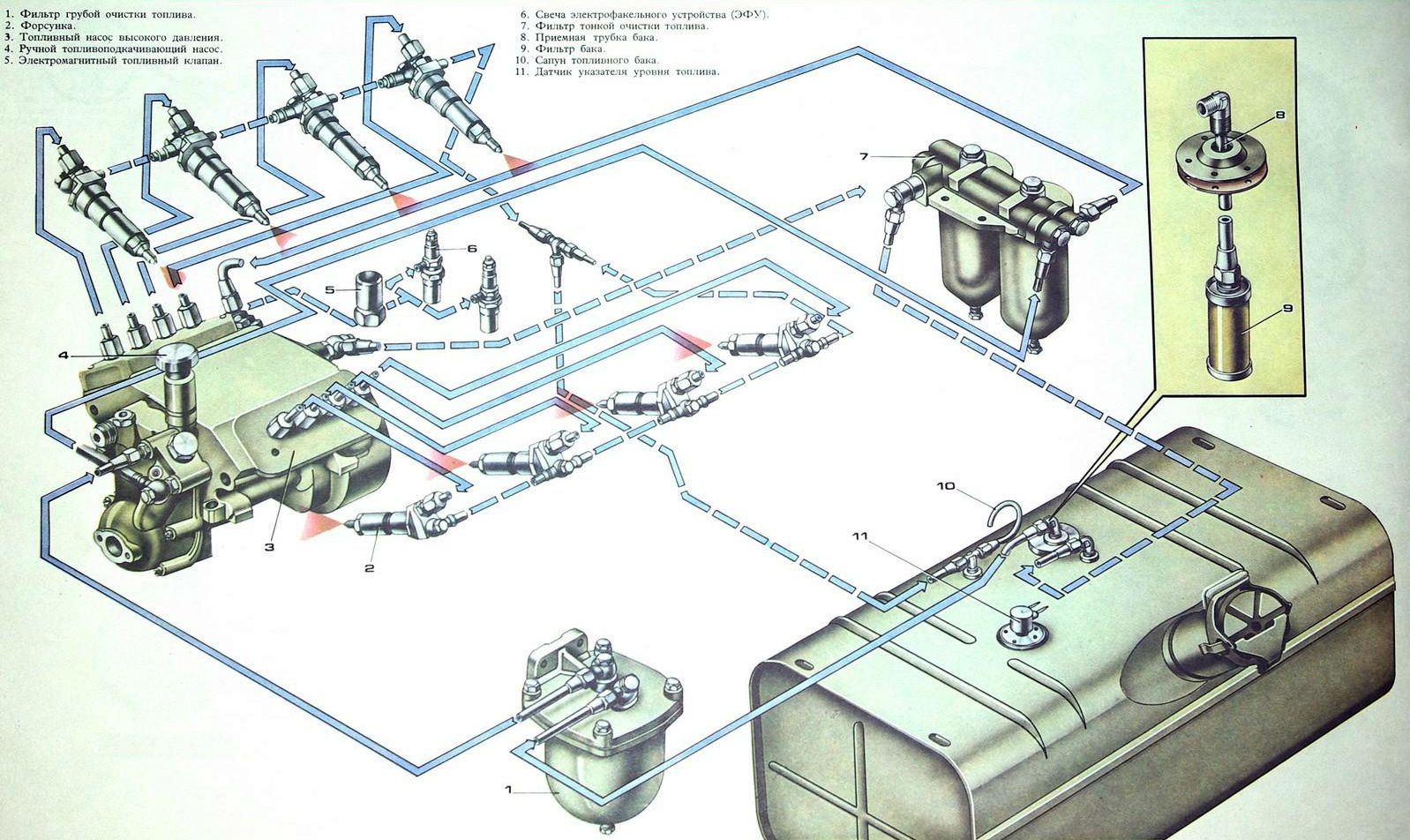
The diesel system requires high accuracy and increased control, so the maintenance of these engines is expensive.
Nowadays, different cars are installed on cars. fuel systems in which there are many common sites with the same characteristics. Of course, the injection and diesel systems more complexly arranged due to the increased accuracy of fuel injection, however, the unification of parts can greatly facilitate the repair.
The principle of operation of diesel engines is that the fuel is supplied to the engine cylinders by means of injection (similar to injectors). However, this is where the similarities end. The ignition of the fuel mixture occurs without spark plugs due to the high temperature (700 - 800 ° C) in the working chamber.
This temperature is achieved due to a higher compression ratio in the cylinders of a diesel engine (19 - 24) as compared with gasoline engines (9 - 11). Fuel is also injected into cylinders under high pressure (100 - 150 kg / cm²).
For this purpose, fuel pumps are made with minimal gaps between the casing and the feed plungers, which makes them very sensitive to wear or dirt. Therefore, maintenance and repair of fuel equipment of diesel engines has its own specifics. Tell you more about it.
The composition of the fuel system of a diesel engine
The diesel power supply system consists of two circuits: low and high pressure. The composition of the low pressure circuit:
- Gas tank with booster pump located in it. The latter is used with a significant length of the fuel lines.
- Filter separator designed to separate large particles of dirt.
- Fine fuel filter.
- Marching diesel fuel heater, which is installed next to the filtering devices.
- Preheater fuel, activated from the button before starting the engine.
- The first (low pressure) stage of the high pressure fuel pump (high pressure pump).
- Low pressure fuel lines.

The high pressure circuit includes:
- The second (high-pressure) stage of the pump, equipped with a solenoid valve to shut off the fuel supply, used to stop the engine.
- Hydraulic accumulator of high pressure, made in the form of a fuel rail, which includes a pressure regulator and a fuel metering valve (system Common rail).
- Injectors for fuel injection into cylinders.
- High pressure fuel lines.
- Electric glow plugs with a control unit that sets the time of their inclusion.
- The electronic engine control unit (ECU).
System faults with a description of external signs
The table shows the most common malfunctions of the diesel engine power system with an indication of the visible manifestations.
| Malfunction | External symptoms |
| Dirty filter | Power drop, engine stalls |
| Pump does not work | Engine is dead |
| Worn or damaged pump | Difficult start, dips during acceleration, increased fuel consumption |
| Insufficient high pressure | Overclocking Dips |
| Increased injection pressure | High fuel consumption |
| Offset advance angle | Difficult start, stalls engine |
| Early fuel injection | Engine hard work |
| Late fuel injection | Black smoke from the exhaust pipe |
| Nozzle wear | Difficult start, black smoke from exhaust system |
| Unstable glow plugs | Difficulty starting |
| Valve sticking | Black smoke from exhaust pipe |
| Low compression | Difficult start-up, increased diesel consumption |
| Crankshaft governor wear | "Floating" idle |
| Air filter pollution | Overclocking Dips |
| Leakage of sealing washers under nozzles | "Floating" idle |
| Air leaks between filter and pump | |
| Crankcase ventilation clogged |
Diagnostic equipment
The above table is not yet the basis for sending a component that was suspected to be diagnosed, and even more so for repair. These preliminary diagnoses can only be taken into account for older diesel engines that do not have an electronic control system.
If a problem occurs with an engine equipped with an ECU, first of all, it is necessary to diagnose the failure of the fuel system using a diagnostic scanner connected to the K-line connector of the unit.
Only after determining the error code associated with the faulty element should be sent to the station maintenance (SRT) to start repairing the diesel engine power system.
After diagnostic testing, specialists will make a final diagnosis - which of the elements of the power supply system is responsible for the incorrect operation of the diesel engine. Otherwise, at your request, relying on your assumptions, will repair the wrong node, and the problems will remain with you.
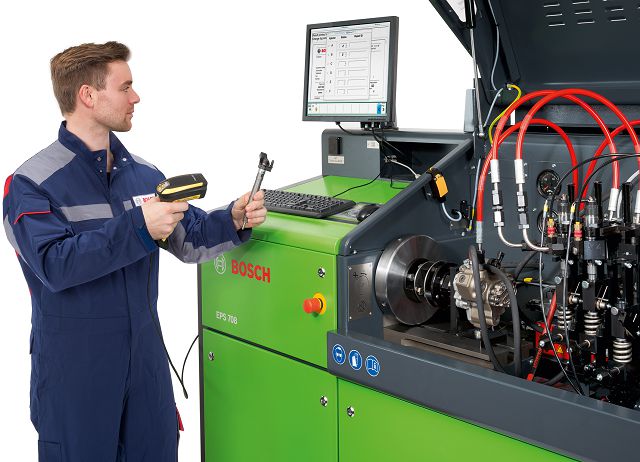
Choosing a service station, you should pay attention to the level of its equipment with diagnostic equipment. The leader in the manufacture of test and repair stands for testing fuel equipment is the company Bosch, which produces a line of equipment EPS.
The EPS 815 booth under the control of a computer system has wide capabilities for testing all types of injection pump. With the help of the EPS 205 benchtop instrument, nozzles of various types and manufacturers are tested using various adapters. Also known diagnostic systems firms Delphi, DENSO and Hartridge.
What is checked
Using the numerous functions of diagnostic systems and devices, you can check a variety of technical parameters and characteristics of fuel components and determine the main problems in the power supply system. Bosch equipment kits perform the following tests and actions:
- low pressure circuit diagnostics (Diesel Set 1);
- removing air from common systems Rail (Diesel Set 2);
- diagnostics of high pressure lines (Diesel Set 3.1).
- the same complex checks: why the engine does not start when the starter is running or the engine is deafening, it finds the causes of a sudden decrease in power in the absence of any trouble codes.
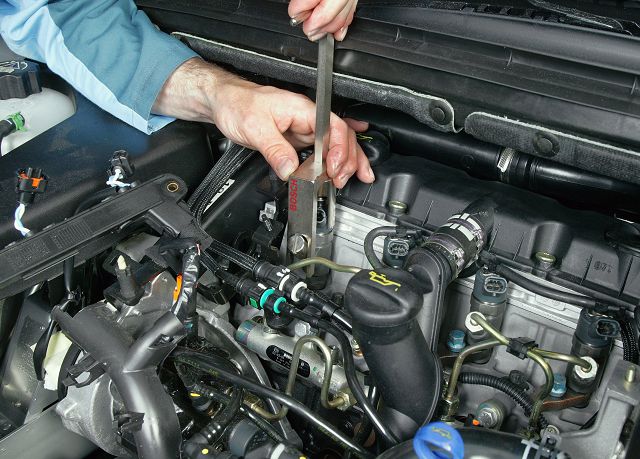
Using an EPS handheld device:
- check and regulate the opening pressure of the injectors;
- analyze the torch spray;
- Nozzle bounce;
- measure leaks in sprayers.
On the stand of Delphi YDT278 all components of the diesel engine fuel system, including the pump and injectors, are checked, even without removing them from the car. By connecting the device YDT410, monitor the operation of the pressure regulator of the Common Rail system. If the device raises the pressure to the required, then the regular regulator is faulty. Otherwise, the source of the malfunction is the pump.
After diagnostic testing and identification of a faulty node, decisions are made about further actions. In principle, almost any component of the fuel system can be repaired by first determining “whether the game is worth the candle”.
Works are performed in specialized service centers. diesel carshaving the necessary equipment for repair. How to restore worn units?
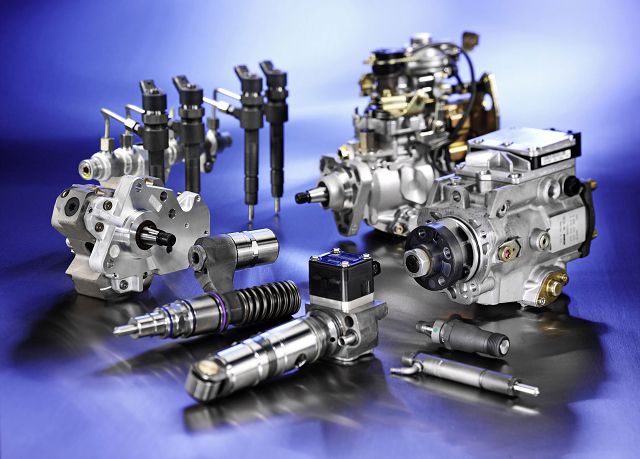
The main actions in the repair of fuel pump to the service station:
- disassembling and cleaning the unit with washing parts in fuel;
- device troubleshooting;
- preliminary and final grinding of holes;
- chromium plungers to increase their diameter;
- grinding plungers with GOI paste;
- sorting plungers into groups with a diameter difference of not more than 2 microns;
- selection of plunger pairs in such a way that the plunger enters into the hole no more than two-tenths of its length;
- grinding on finishing machine with GOI paste;
- pump assembly;
- replacement of rubber seals (rings, cuffs, oil seals);
- bench setting work.
Repair of nozzles or pump nozzles includes:
- disassembling and washing parts in fuel;
- cleaning the surface from carbon;
- sprayer replacement;
- replacement of failed parts (sealing washers, spring, needle, intermediate pusher);
- setting up the injectors.
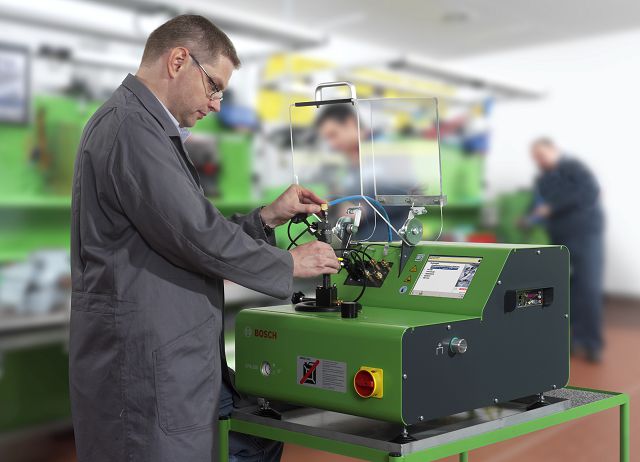
- How to find out if air is being sucked into the fuel system or not? Disconnect the hose from fuel filter and immerse it in a tank of fuel. If the engine runs better, look for the location of the leak.
- In the fall, with the onset of cold weather, drain the remainder of the summer fuel and refuel with winter diesel fuel, otherwise paraffin crystals form in the system, which will require expensive dewaxing operation fuel tank.
- If a motorist recently moved to a diesel from a gasoline car, do not twist the engine up to 3,500 rpm. With such a load, its life is reduced, since parts wear out much faster. Try not to exceed the speed of more than 3 thousand.
- Periodically drain the water from the filter-sump. Starting the engine, especially in winter, thanks to this measure, will become more successful.
- Do not allow a long drive with a half-empty fuel tank, as a result of which condensate is released on its walls, and oxides are formed that enter fuel.
As doctors say, the disease is easier to prevent than to cure. The same can be said for the repair of the diesel engine fuel system.
Timely preventive work: replacing filters, draining condensate, regular flushing of the fuel tank, checking on diagnostic equipment will help you increase the service life of all components of the fuel system and save on costly repairs.






